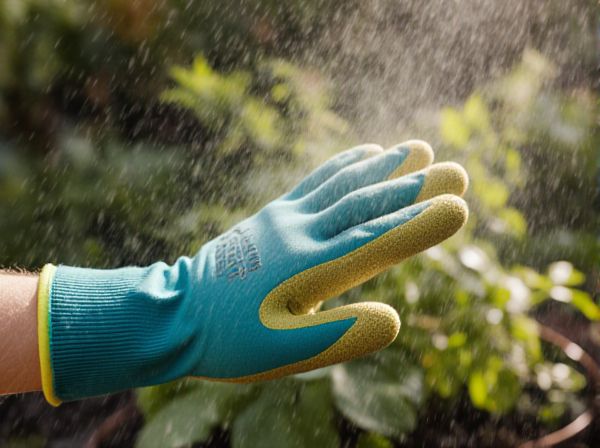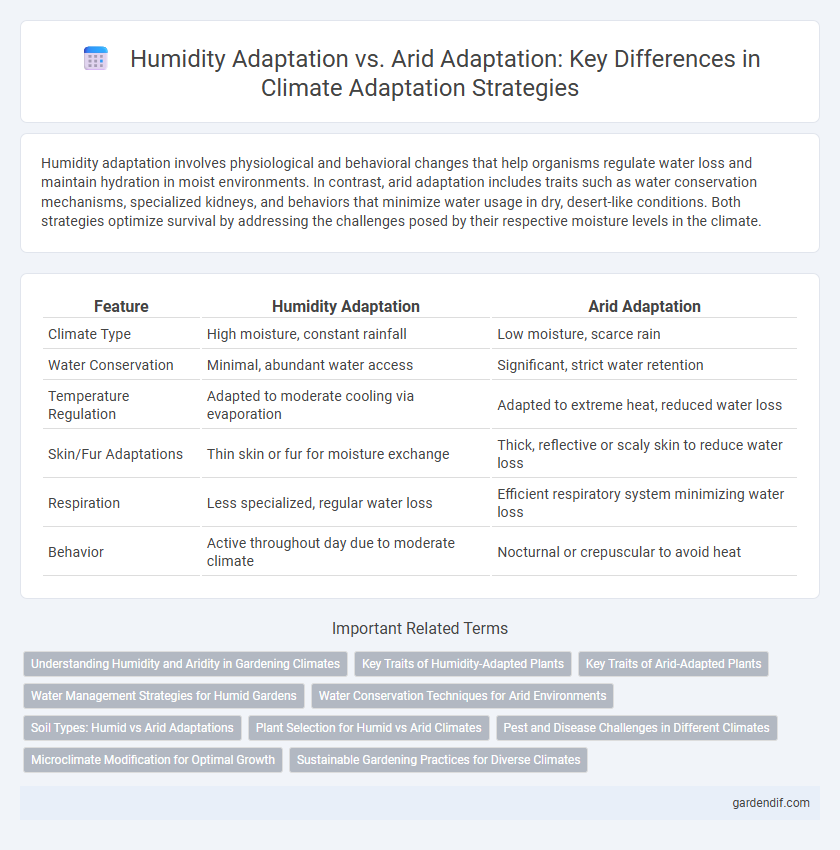
Humidity adaptation vs Arid adaptation Illustration
Humidity adaptation involves physiological and behavioral changes that help organisms regulate water loss and maintain hydration in moist environments. In contrast, arid adaptation includes traits such as water conservation mechanisms, specialized kidneys, and behaviors that minimize water usage in dry, desert-like conditions. Both strategies optimize survival by addressing the challenges posed by their respective moisture levels in the climate.
Table of Comparison
| Feature | Humidity Adaptation | Arid Adaptation |
|---|---|---|
| Climate Type | High moisture, constant rainfall | Low moisture, scarce rain |
| Water Conservation | Minimal, abundant water access | Significant, strict water retention |
| Temperature Regulation | Adapted to moderate cooling via evaporation | Adapted to extreme heat, reduced water loss |
| Skin/Fur Adaptations | Thin skin or fur for moisture exchange | Thick, reflective or scaly skin to reduce water loss |
| Respiration | Less specialized, regular water loss | Efficient respiratory system minimizing water loss |
| Behavior | Active throughout day due to moderate climate | Nocturnal or crepuscular to avoid heat |
Understanding Humidity and Aridity in Gardening Climates
Gardeners must understand humidity adaptation as the ability of plants to thrive in moist, high-humidity environments, where air moisture influences transpiration and disease susceptibility. Arid adaptation refers to plant survival mechanisms in dry, low-humidity climates, including water conservation strategies like deep root systems and reduced leaf surface area. Selecting plants suited to the specific humidity or aridity conditions of a gardening climate ensures optimal growth, water efficiency, and resilience against environmental stress.
Key Traits of Humidity-Adapted Plants
Humidity-adapted plants typically exhibit broad leaves with a thin cuticle to maximize transpiration and gas exchange in moist environments. These plants often develop large stomatal pores that remain open longer, facilitating efficient water vapor release and nutrient uptake. Furthermore, they possess shallow root systems optimized for rapid absorption of surface water, differentiating them from arid-adapted species with deep roots and water-conserving features.
Key Traits of Arid-Adapted Plants
Arid-adapted plants exhibit key traits such as deep root systems to access underground water, thick and waxy cuticles that minimize water loss, and reduced leaf surface area to decrease transpiration rates. These adaptations enable survival in environments with extreme water scarcity and high temperatures. Such xerophytic features often include CAM photosynthesis, allowing efficient carbon fixation during cooler night hours to conserve moisture.
Water Management Strategies for Humid Gardens
Humid gardens rely on water management strategies that optimize natural moisture retention through mulching, rainwater harvesting, and the use of native plants adapted to frequent rainfall. These gardens employ soil amendments such as organic compost to improve water infiltration and reduce surface runoff, ensuring sustained hydration during intermittent dry spells. Efficient drainage systems are critical to prevent waterlogging, promoting healthy root environments that support robust plant growth in high-humidity climates.
Water Conservation Techniques for Arid Environments
Arid environments demand specialized water conservation techniques such as minimizing stomatal openings, developing thick cuticles, and accumulating osmoprotectants to retain moisture. Plants often exhibit xerophytic adaptations like deep root systems and CAM photosynthesis to optimize water use in extreme drought conditions. These strategies contrast with humidity adaptation, where excess moisture reduces the need for stringent water-saving mechanisms.
Soil Types: Humid vs Arid Adaptations
Humid adaptation favors soil types with high organic matter and moisture retention, such as loamy and clay soils, which support diverse plant growth and microbial activity. Arid adaptation relies on sandy and rocky soils with low water-holding capacity, requiring specialized root systems and drought-resistant vegetation to conserve water. Soil structure and nutrient availability are crucial factors influencing the survival strategies of flora in both humid and arid environments.
Plant Selection for Humid vs Arid Climates
Plants selected for humid climates exhibit traits like broad, thin leaves to maximize transpiration and thrive in moisture-rich environments, while species adapted to arid climates possess thick, waxy cuticles and reduced leaf surface area to minimize water loss. Succulents and deep-rooted shrubs dominate arid zones, efficiently storing water and accessing deep soil moisture, contrasting with the fast-growing, shallow-rooted plants common in humid regions. Understanding these adaptations guides optimal plant selection for landscaping and agriculture, ensuring resilience and sustainability in varying climatic conditions.
Pest and Disease Challenges in Different Climates
Humidity adaptation in crops often involves enhanced resistance to fungal and bacterial pathogens that thrive in moist conditions, while arid adaptation emphasizes tolerance to pests such as aphids and mites that proliferate in dry environments. High humidity promotes the spread of diseases like powdery mildew and downy mildew, necessitating crops with robust disease resistance genes. Conversely, arid climates challenge plant defenses against desiccation-tolerant insects and soil-borne pathogens, requiring drought-resistant and pest-resilient traits.
Microclimate Modification for Optimal Growth
Humidity adaptation involves organisms or plants modifying microclimates by increasing local moisture levels through transpiration or shading, enhancing water retention and promoting optimal growth in humid environments. Arid adaptation focuses on reducing water loss and altering soil microenvironments using reflective surfaces or deep root systems to maintain cooler, moister conditions essential for survival. Microclimate modification strategies tailored to humidity or arid conditions optimize temperature regulation, moisture availability, and nutrient uptake, driving sustainable growth and ecosystem resilience.
Sustainable Gardening Practices for Diverse Climates
Sustainable gardening practices for diverse climates emphasize selecting plants with humidity adaptation for moist environments and arid adaptation for dry regions, ensuring resource-efficient water use. Techniques such as mulching and drip irrigation optimize moisture retention in arid climates, while rain gardens and proper drainage improve soil aeration in humid areas. Integrating native species adapted to local humidity levels enhances ecosystem resilience and reduces maintenance requirements.
Humidity adaptation vs Arid adaptation Infographic

 gardendif.com
gardendif.com